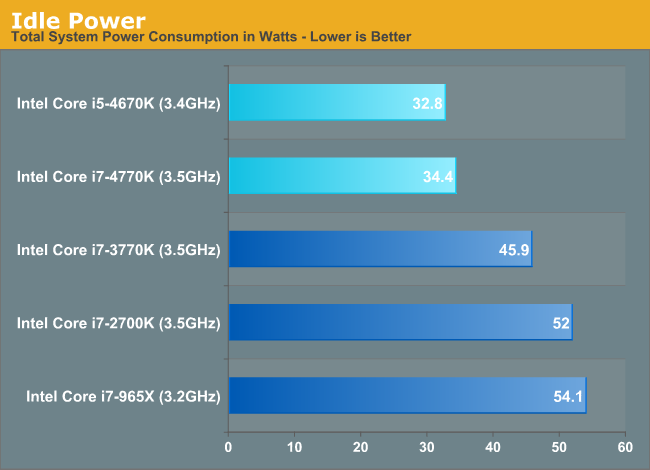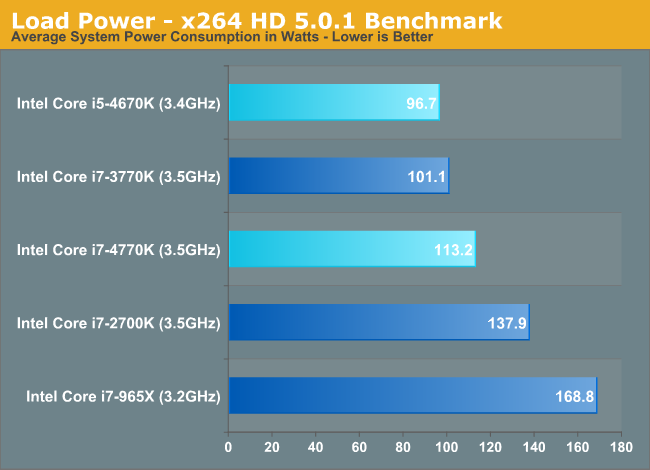The Haswell Review: Intel Core i7-4770K & i5-4670K Tested
by Anand Lal Shimpi on June 1, 2013 10:00 AM ESTPower Improvements
Although Haswell’s platform power is expected to drop considerably in mobile, particularly with Haswell U and Y SKUs (Ultrabooks and ultrathins/tablets), there are benefits to desktop Haswell parts as well.
There’s more fine grained power gating, lower chipset power and the CPU cores can transition between power states about 25% quicker than in Ivy Bridge - allowing the power control unit to be more aggressive in selecting lower power modes. We’ve also seen considerable improvements on lowering platform power consumption at the motherboard level as well. Using ASUS’ Z77 Deluxe and Z87 Deluxe motherboards for the Haswell, Ivy and Sandy Bridge CPUs, I measured significant improvements in idle power consumption:

These savings are beyond what I’d expect from Haswell alone. Intel isn’t the only one looking to make things as best as can be in the absence of any low hanging fruit. The motherboard makers are aggressively polishing their designs in order to grow their marketshare in a very difficult environment.
Under load, there’s no escaping the fact that Haswell can burn more power in pursuit of higher performance:

Here I’m showing an 11.8% increase in power consumption, and in this particular test the Core i7-4770K is 13% faster than the i7-3770K. Power consumption goes up, but so does performance per watt.
The other big part of the Haswell power story is what Intel is calling FIVR: Haswell’s Fully Integrated Voltage Regulator. Through a combination of on-die and on-package circuitry (mostly inductors on-package), Haswell assumes responsibility of distributing voltages to individual blocks and controllers (e.g. PCIe controller, memory controller, processor graphics, etc...). With FIVR, it’s easy to implement tons of voltage rails - which is why Intel doubled the number of internal voltage rails. With more independent voltage rails, there’s more fine grained control over the power delivered to various blocks of Haswell.
Thanks to a relatively high input voltage (on the order of 1.8V), it’s possible to generate quite a bit of current on-package and efficiently distribute power to all areas of the chip. Voltage ramps are 5 - 10x quicker with FIVR than with a traditional on-board voltage regulator implementation.
In order to ensure broad compatibility with memory types, there’s a second input voltage for DRAM as well.
FIVR also comes with a reduction in board area and component cost. I don’t suppose this is going to be a huge deal for desktops (admittedly the space and cost savings are basically non-existent), but it’ll mean a lot for mobile.
No S0ix for Desktop
You’ll notice that I didn’t mention any of the aggressive platform power optimizations in my sections on Haswell power management, that’s because they pretty much don’t apply here. The new active idle (S0ix) states are not supported by any of the desktop SKUs. It’s only the forthcoming Y and U series parts that support S0ix.










210 Comments
View All Comments
eckre - Friday, June 14, 2013 - link
VERY disappointing CPU, if you disregard ALL of the fake synthetic benchmarks, and use only the real world ones, the gains over the 3770K are 0.03%, max 8.8% and average at about a 3% Improvement. 3%? Not worth it. Motherboard? Z87 was suppose to drop PCI but all the motherboards still have it and nothing outrageous. So basically lower power consumption, better on board video performance and no discernible improvement over the 3770K.i7Ahmed920D0 - Monday, June 24, 2013 - link
GOOD BYE 920 D0 Ill never forget you ! Your going to moms rig ! Helllllooooo 4670k with upto 40% better performance for 225 bucks !Yangorang - Thursday, June 27, 2013 - link
There are some rumors that the Haswell desktop processors run fairly hot - can you confirm this at all in your testing?calico-uk - Friday, July 12, 2013 - link
Face it, A consumers market, not a true imagine of technology evolution. Low power with high temps? Just doesn't ring true, unless the chip has been purposely ' Restricted ' with only one cause in mind sales and protection of future sales. In layman's terms Greedy bastards more concerned with markets and money and not the Desktop guy who's impressed with performance. Blame Mac, Windows 8. And your tiny fucking phone.James McGrath - Sunday, August 11, 2013 - link
This test is a little bias against the Core 2 duo I think. What they have done is essentially pitch the very top end on Intel's last 4 generations against a mid to low end core 2 duo. It would be more fair if that generation was represented by a qx9770 or even a Q9650.clyman - Wednesday, October 23, 2013 - link
I have been involved in computer hardware, software and programming since 1986. There has never been a more reliable processor than Intel, at any time. The current ones still have to be tested over time, but I would not buy one. If you put enough case fans with the inferior processors, they might last 2 or 3 years. With an Intel processor, even overclocked with no case fans, provided you used the intel chipset, nearly 100% of them kept running for 5 or more years. Without overclocking, I still don't know when they will die, since none have to my knowledge. I have built at least 100 computers and have only built a couple non intel ones. It was obvious right away how inferior they were to intel. Also, I love my i7 haswell on an asus z87-pro motherboard. There is no need to overclock, the processor and memory score 7.8 out of 7.9 on the windows scale and the onboard graphics scores a 6.8. Not bad ratings. Also, the CPU only uses 7 to 8 watts of power most of the time.numskulll - Tuesday, November 5, 2013 - link
I'm quite happy with my undervolted Athlon 620 and Radeon 4200 graphics. More computing power than I need 99% of the time, estimated tdp of about 55-60 watts (1% of use) and system idle of about 40w (80+% of use). And if I ever play games it takes a few seconds to bung in a suitable graphics card. I doubt it will go belly-up in the foreseeable future, but if it does it only cost £50 second-hand about 3 years ago and would be even less to buy now.duttasanjiv - Friday, November 14, 2014 - link
I am planning to get a new i5 4690 system for 1080p transcoding. I am not interested in GPU assisted transcoding. My focus is on QuickSync assisted transcoding. It is said that latest Quicksync is almost comparable to CPU based transcoding.It is annoying to see all sites compare only obsolate systems with a vague spec. (including AnandTech). Then, they omit any screenshots. Some are so weird thay put the video at youtube!! How can one compare the quality after youtube again transcoded it?
So far I am looking for a scientific, specific comparison on -
1) i5 4690 or atleast 4570 with CPU only & with QS
2) Screenshots in PNG
3) Specifying what settings were used? What QRF / what QCF? What speed presets - 'slow' or medium? What profile - high or main?. 'faster' or 'very fast' settings speed presets is worthless.
2) What is the source format - 1080i or 1080p? How long? What was the target size.
3) What QuickSync performance settings were used? I heard that haswell supports 7 performance vs quality settings. Also never found if QS supports any other parameters.
Merely mentioning FPS or time won't help.
I request you to pl. provide us with such an comprehensive comparison with will help many users like me, to settle all doubts for good. Thx so much in advance...
minitt - Sunday, December 7, 2014 - link
They dropped I5 750 and I7 920 from the gaming benchmark because both the processor will put up decent FPS which will take away most of the lime light from the haswell. A 4.0 ghz clocked i5 750 or i7 920 is still capable of keeping the modern GPUs running at 100% .I would be more than happy if someone can prove me wrong.Miller1331 - Tuesday, December 1, 2015 - link
I have the 4770k in my Desktop which is used primarily for high end music production and it eats up everything I have thrown at it thus far